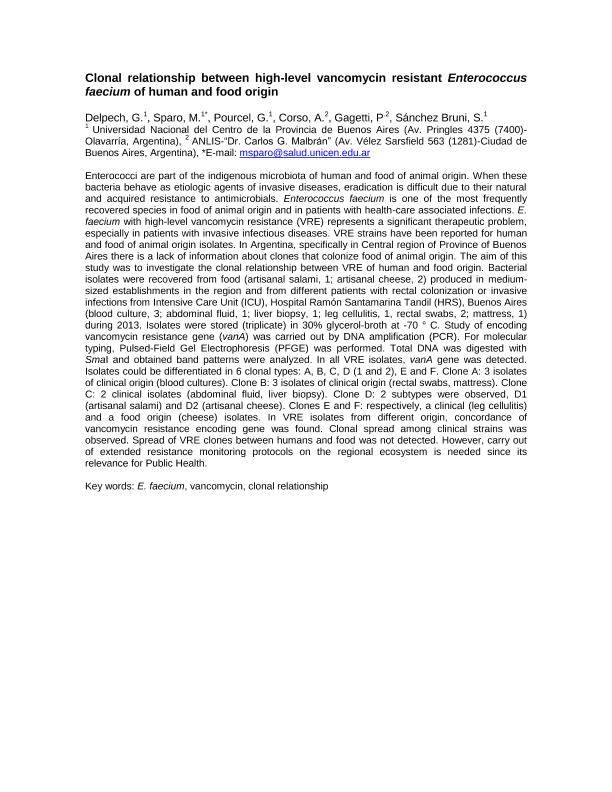Evento
Clonal relationship between high-level vancomycin resistant Enterococcus faecium of human and food origin
Delpech, Gastón ; Sparo, Mónica Delfina; Pourcel, Gisela; Corso, Alejandra; Gaguetti, Paula; Sanchez Bruni, Sergio Fabian
; Sparo, Mónica Delfina; Pourcel, Gisela; Corso, Alejandra; Gaguetti, Paula; Sanchez Bruni, Sergio Fabian
 ; Sparo, Mónica Delfina; Pourcel, Gisela; Corso, Alejandra; Gaguetti, Paula; Sanchez Bruni, Sergio Fabian
; Sparo, Mónica Delfina; Pourcel, Gisela; Corso, Alejandra; Gaguetti, Paula; Sanchez Bruni, Sergio Fabian
Tipo del evento:
Congreso
Nombre del evento:
28º Congresso Brasileiro de Microbiologia
Fecha del evento:
18/10/2015
Institución Organizadora:
Sociedade Brasileira de Microbiología;
Título del Libro:
Anais do 28º Congresso Brasileiro de Microbiologia
Editorial:
Sociedade Brasileira de Microbiologia
ISBN:
978-85-5522-026-5
Idioma:
Inglés
Clasificación temática:
Resumen
Enterococci are part of the indigenous microbiota of human and food of animal origin. When these bacteria behave as etiologic agents of invasive diseases, eradication is difficult due to their natural and acquired resistance to antimicrobials. Enterococcus faecium is one of the most frequently recovered species in food of animal origin and in patients with health-care associated infections. E. faecium with high-level vancomycin resistance (VRE) represents a significant therapeutic problem, especially in patients with invasive infectious diseases. VRE strains have been reported for human and food of animal origin isolates. In Argentina, specifically in Central region of Province of Buenos Aires there is a lack of information about clones that colonize food of animal origin. The aim of this study was to investigate the clonal relationship between VRE of human and food origin. Bacterial isolates were recovered from food (artisanal salami, 1; artisanal cheese, 2) produced in mediumsized establishments in the region and from different patients with rectal colonization or invasive infections from Intensive Care Unit (ICU), Hospital Ramón Santamarina Tandil (HRS), Buenos Aires (blood culture, 3; abdominal fluid, 1; liver biopsy, 1; leg cellulitis, 1, rectal swabs, 2; mattress, 1) during 2013. Isolates were stored (triplicate) in 30% glycerol-broth at -70 ° C. Study of encoding vancomycin resistance gene (vanA) was carried out by DNA amplification (PCR). For molecular typing, Pulsed-Field Gel Electrophoresis (PFGE) was performed. Total DNA was digested with SmaI and obtained band patterns were analyzed. In all VRE isolates, vanA gene was detected. Isolates could be differentiated in 6 clonal types: A, B, C, D (1 and 2), E and F. Clone A: 3 isolates of clinical origin (blood cultures). Clone B: 3 isolates of clinical origin (rectal swabs, mattress). Clone C: 2 clinical isolates (abdominal fluid, liver biopsy). Clone D: 2 subtypes were observed, D1 (artisanal salami) and D2 (artisanal cheese). Clones E and F: respectively, a clinical (leg cellulitis) and a food origin (cheese) isolates. In VRE isolates from different origin, concordance of vancomycin resistance encoding gene was found. Clonal spread among clinical strains was observed. Spread of VRE clones between humans and food was not detected. However, carry out of extended resistance monitoring protocols on the regional ecosystem is needed since its relevance for Public Health.
Palabras clave:
Enterocccus
,
Vancomicina
,
Resistencia
,
Clonal relationship
,
Vancomycin
Archivos asociados
Licencia
Identificadores
Colecciones
Eventos(CIVETAN)
Eventos de CENTRO DE INVESTIGACION VETERINARIA DE TANDIL
Eventos de CENTRO DE INVESTIGACION VETERINARIA DE TANDIL
Citación
Clonal relationship between high-level vancomycin resistant Enterococcus faecium of human and food origin; 28º Congresso Brasileiro de Microbiologia; Florianpolis; Brasil; 2015; 1-1
Compartir



